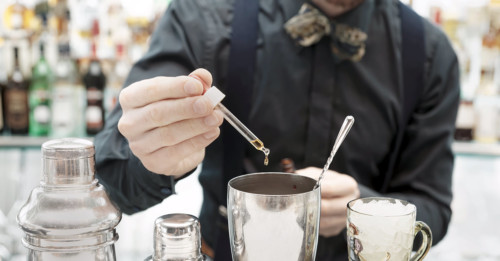By “bitters,” we don’t mean the angry thoughts you have about the bartender ignoring you. Bitters are the slightly confusing name given to a class of liquor-based flavoring agents used for everything from stomachaches to cocktail recipes (confusing because they’re not necessarily bitter). Generally sold in a small bottle, they pack a lot of flavor in drop-size doses, so it’s good to know a thing or two about them before you buy, certainly before you try.
Bitters are made by infusing a neutral spirit with any number of aromatics, including spices, tree bark, roots, seeds, fruits, etc. Since before the cocktail itself, bitters were originally developed and marketed for medicinal purposes, with ingredients generally thought to impart good health preserved in a neutral liquor. As with most marketing campaigns, health claims began to be a bit outlandish—restoring youthful vigor, curing malaria, e.g.—but thankfully for all involved, bitters eventually found their way from the medicine cabinet to the liquor cabinet.
In fact, they have such an established place in spirits that even if you’re not a cocktail drinker, you’ve probably heard of a few of the most popular types of bitters. There’s Peychaud’s, used in the Sazerac and developed in 1830 by Antoine Amedee Peychaud, a Haitian apothecary who settled in New Orleans. There’s Angostura, with their oversize label, found in everything from the Old Fashioned to hangover cures. And then, in a different class, orange bitters, clear orange-hued citrus bitters with a complex of lighter-spectrum flavors that vary from brand to brand.
Bitters brands are actually part of the expansion of spirits products brought on by the craft distilling boom. Thanks to a massive variety of new spirits, and an ambitious population of bartenders looking for new flavor profiles to mix cocktails with, the opportunity for innovatively flavored bitters expands. Which is how you get everything from more traditional grapefruit bitters to things like Cumin Bitters, Mexican Mole Bitters, and Memphis Barbecue Bitters.
Especially with so much variety on hand, it should be noted that cocktail bitters—the kind that come in tiny bottles with a dropper attached to the cap—shouldn’t be confused with potable bitters, which are bitter liqueurs or Amari, not quite as potently flavored as cocktail bitters, meaning they can be consumed in quantity (ounces rather than drops). It’s pretty easy to tell the difference, since no one would put anything in such a small bottle if you were meant to drink it by the shot. Of course, if you ever did try to drink non-potable bitters like Angostura in quantity, your taste buds just might go on strike for a week or two, no harm, no foul. Though also, no malaria cure.
